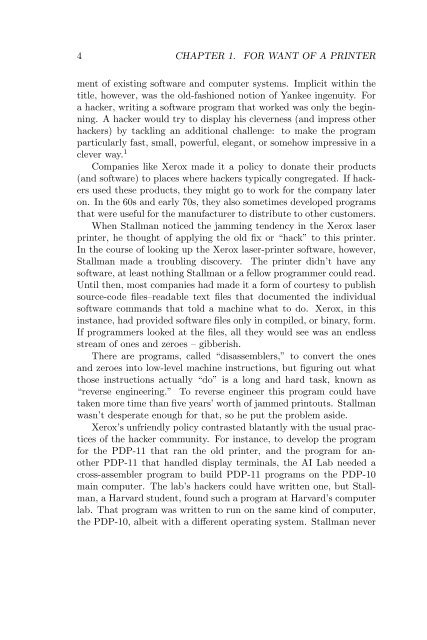Create successful ePaper yourself
Turn your PDF publications into a flip-book with our unique Google optimized e-Paper software.
4 CHAPTER 1. FOR WANT OF A PRINTER<br />
ment of existing software and computer systems. Implicit within the<br />
title, however, was the old-fashioned notion of Yankee ingenuity. For<br />
a hacker, writing a software program that worked was only the beginning.<br />
A hacker would try to display his cleverness (and impress other<br />
hackers) by tackling an additional challenge: to make the program<br />
particularly fast, small, powerful, elegant, or somehow impressive in a<br />
clever way. 1<br />
Companies like Xerox made it a policy to donate their products<br />
(and software) to places where hackers typically congregated. If hackers<br />
used these products, they might go to work for the company later<br />
on. In the 60s and early 70s, they also sometimes developed programs<br />
that were useful for the manufacturer to distribute to other customers.<br />
When Stallman noticed the jamming tendency in the Xerox laser<br />
printer, he thought of applying the old fix or “hack” to this printer.<br />
In the course of looking up the Xerox laser-printer software, however,<br />
Stallman made a troubling discovery. The printer didn’t have any<br />
software, at least nothing Stallman or a fellow programmer could read.<br />
Until then, most companies had made it a form of courtesy to publish<br />
source-code files–readable text files that documented the individual<br />
software commands that told a machine what to do. Xerox, in this<br />
instance, had provided software files only in compiled, or binary, form.<br />
If programmers looked at the files, all they would see was an endless<br />
stream of ones and zeroes – gibberish.<br />
There are programs, called “disassemblers,” to convert the ones<br />
and zeroes into low-level machine instructions, but figuring out what<br />
those instructions actually “do” is a long and hard task, known as<br />
“reverse engineering.” To reverse engineer this program could have<br />
taken more time than five years’ worth of jammed printouts. Stallman<br />
wasn’t desperate enough for that, so he put the problem aside.<br />
Xerox’s unfriendly policy contrasted blatantly with the usual practices<br />
of the hacker community. For instance, to develop the program<br />
for the PDP-11 that ran the old printer, and the program for another<br />
PDP-11 that handled display terminals, the AI Lab needed a<br />
cross-assembler program to build PDP-11 programs on the PDP-10<br />
main computer. The lab’s hackers could have written one, but Stallman,<br />
a Harvard student, found such a program at Harvard’s computer<br />
lab. That program was written to run on the same kind of computer,<br />
the PDP-10, albeit with a different operating system. Stallman never


